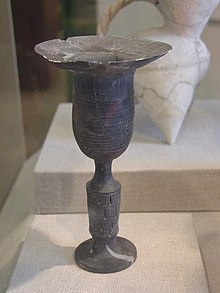Longshan culture
The Longshan culture ( Chinese 龍山 文化 / 龙山 文化 , Pinyin Lóngshān wénhuà ) was a late Neolithic culture on the middle and lower Yellow River in China . It was named after the Longshan landscape (ie "Dragon Mountains", "Dragon Mountain") in Shandong Province , where the first discoveries of this culture were made in 1929. Depending on the source, it is dated to around 3200 BC. BC to 1850 BC Dated.
The Longshan culture with its black ceramics superimposed the Yangshao culture (that is, the culture of painted pottery, 5000-2000 BC) at least in Henan Province . In other areas, however, both cultures could have coexisted.
Longshan is characterized by a special type of ceramic . It has a glossy black or gray surface, little decoration and is sometimes as thin-walled as an eggshell.
Initially (around 3000 BC), gray goods were used with string, mat or notch decoration, often black paint on a red background. Then this fine, hard, thin-walled and shiny black ceramic spread, for which black, i.e. iron-rich clay was used, the hallmark of Longshan. It is only found frequently in Shandong , which means that elsewhere at the same time a coarser and differently colored ceramic was predominant. The black pottery was followed by the gray pottery very similar to that of Longshan, with thin walls and other decorations, found in Xiaodun ( Shanxi ) and immediately afterwards the Bronze Age.
Longshan ceramics were the first in China to be made using a potter's wheel . There is no reference to pottery wheels in the earlier Yangshao ceramics.
In addition to other shapes, there are also vessels with three legs, the appearance of which was then imitated in the Bronze Age (= ding ).
During the Longshan culture, villages with walls made of rammed earth (hang-t'u) were built as permanent dwellings on heights along the rivers. For this purpose, the clay was tamped in layers in a casing. From such villages several power centers of the Shang period developed . In contrast, the Yangshao village was only temporarily used and unpaved. Pigs, sheep and cattle were kept, but not horses. The cultivation of rice became common at this time.
The Longshan culture was patriarchal . This can be seen from the arrangement of the skeletons in the graves in which the woman was assigned to the man. In contrast, the earlier Yangshao culture (5000–2000 BC) was apparently still matriarchal.
There are also pieces of jewelry made of jade . So there was an upper class that developed during the Longshan period and whose existence is also reflected in the graves.
Another characteristic of the Longshan culture is the appearance of the bone oracle (scapulomancy), for which bones were drilled and glowing pieces of wood stuck into them to reveal the cracks.
The Chinese Neolithic population peaked during the Longshan culture. Towards the end there was then a strong decline, as evidenced by a decrease in high-quality black pottery at ritual funerals.
Chinese archaeologists usually differentiate between the Longshan cultures: Longshan culture from Shandong, Longshan culture of the second period of Miaodigou culture, Longshan culture from Henan, Longshan culture from Shanxi and Longshan culture from Taosi . It is more broadly divided into the Longshan culture in Shandong and a central Chinese Longshan culture.
A series of local migrations brought the Longshan culture to the central reaches of the Yangtze, on the south China coast and early, that is, around 2500 BC. Until Taiwan .
The Longshan culture is a direct ancestor of the Shang culture , the first "Chinese" culture. The beginning of the Bronze Age (approx. 2000 BC in Gansu ) then marked around 1800 BC. Their end.
literature
- Li Liu: The Chinese Neolithic. Trajectories to early States (= New Studies in Archeology ). Cambridge University Press, Cambridge et al. 2004, ISBN 0-521-81184-8 .
- Zhongguo da baike quanshu: Kaoguxue [Great Chinese Encyclopedia, Volume: Archeology], Beijing: Zhongguo da baike quanshu, 1986 ( online text )
